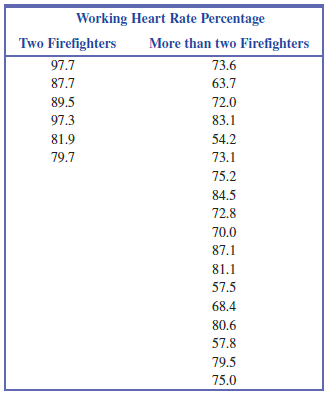The Sheboygan (Wisconsin) Fire Department received a report on the potential effects of reductions in the number
Question:
The Sheboygan (Wisconsin) Fire Department received a report on the potential effects of reductions in the number of firefighters it employs (?Study of Fire Department Causes Controversy,? USA TODAY NETWORK-Wisconsin, December 22, 2016). In one section of the report, the average working heart rate percentage (the percentage value of the observed maximum heart rate during firefighting drills divided by an age-adjusted maximum heart rate for each firefighter) was reported for the driver of the first-arriving fire engine when only two firefighters (including the driver) were present, and for the driver of the first-arriving fire engine when more than two firefighters (up to five) were present. The average working heart rate percentages were based on an earlier study, which included data from a sample of six drills using only two firefighters and from a sample of 18 drills using more than two firefighters. For purposes of this exercise, assume that these samples are representative of all drills with two firefighters and all drills with more than two firefighters.
The following data values are consistent with summary statistics given in the paper. Do these data support the claim that the mean average working heart rate percentage for the driver in a two-firefighter team is greater than the mean average working heart rate percentage for the driver in teams containing from three to five firefighters? Use a 0.05 significance level to carry out a randomization test of the given claim. You can make use of the Shiny apps in the collection at statistics.cengage.com/PSO6e/Apps.html.?

Step by Step Answer:

Introduction To Statistics And Data Analysis
ISBN: 9781337793612
6th Edition
Authors: Roxy Peck, Chris Olsen, Tom Short





